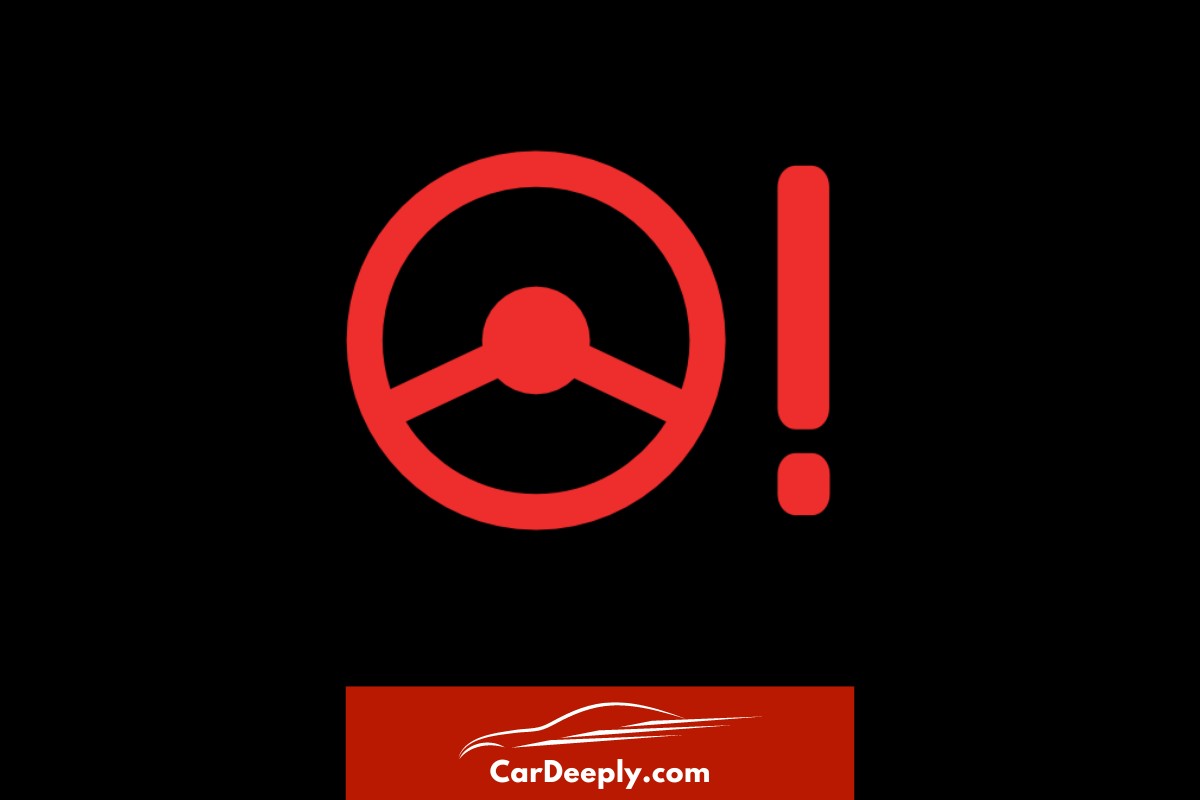Ever been cruising along when suddenly, a mysterious light pops up on your dashboard – the Power Steering Warning Light?
Don’t panic!
This guide is your lifesaver, steering you away from common mistakes and towards a smooth ride. You’ll discover:
- The real meaning behind that pesky light.
- Common causes triggering the warning.
- Practical, easy-to-follow solutions.
Let’s dive in and turn that warning light into a green light for your journey!
Advertising links are marked with *. We receive a small commission on sales, nothing changes for you.
Key Takeaways

- The Power Steering Warning Light indicates potential issues with your steering system.
- Power steering, either hydraulic or electric, is crucial for safe and comfortable driving.
- Common causes for the warning light include low fluid level, leaks, and system failures.
- Immediate response to the warning light is essential, often requiring professional help.
- Regular maintenance can prevent power steering problems and ensure safe driving.
Understanding the Power Steering Warning Light
Ever noticed a little icon on your dashboard showing a steering wheel with an exclamation mark?
That’s your Power Steering Warning Light.
It’s a little beacon alerting you that something’s up with your car’s power steering system. But what exactly does it mean?
And why should you care?
Let’s break it down:
- It’s a warning: Your car is trying to tell you that there’s a potential issue with the power steering system.
- It’s about safety: Power steering is crucial for controlling your vehicle, especially at high speeds and during turns.
- It’s about comfort: Power steering makes driving less physically demanding, particularly in heavy traffic or tight parking spots.
Reding Tip: See the meaning of all car warning lights in this post.
The Importance of Power Steering in Vehicles
Power steering is no luxury – it’s a necessity for everyday driving. Imagine trying to parallel park or make a U-turn without it – sounds like a workout, right?
Here’s why power steering is a big deal:
- It makes driving easier: Power steering reduces the effort needed to turn the steering wheel, making your drive smoother and more enjoyable.
- It enhances control: Power steering allows you to maneuver your vehicle precisely, improving road safety.
- It saves energy: Without power steering, you’d use much muscle power to steer, especially at low speeds or when parking.
How Power Steering Systems Work: Hydraulic vs. Electric
Power steering systems come in two main types: hydraulic and electric. Each has its unique features and benefits:
Hydraulic Power Steering Systems
These systems use a pump driven by the car’s engine to pressurize hydraulic fluid, providing the force needed to assist in steering. Here’s what you need to know:
- They’re reliable: Hydraulic systems have been around for a long time and are known for their durability.
- They require fluid: These systems use a special power steering fluid that needs to be maintained at the right level for optimal performance.
- They can leak: One common issue with hydraulic systems is fluid leaks, leading to the power steering warning light coming on.
Electric Power Steering Systems
On the other hand, electric systems use an electric motor instead of a hydraulic pump. Here’s the scoop:
- They’re efficient: Electric systems use energy only when steering assistance is needed, which can improve fuel efficiency.
- They’re quiet: Electric systems tend to operate more quietly without the hydraulic pump whirring away.
- They’re self-monitoring: Electric systems often have sensors that can detect and alert you to potential issues, hence the power steering warning light.
Understanding these systems is the first step to deciphering the mystery of the power steering warning light. But what causes the light to come on, and what should you do when it does? Stay tuned for Part 2 to find out!
Common Causes of Power Steering Warning Light Illumination
So, you’re cruising along, and suddenly, the power steering warning light pops up on your dashboard. But what’s causing it? Here are some common culprits:
Hydraulic System Issues
- Low fluid level: If your car uses a hydraulic power steering system, the light might tell you the liquid level is low. Time to top it up!
- Fluid leaks: A leak in the system could cause the fluid level to drop, triggering the warning light. You’ll need to find and fix the leak.
- Pump failure: If the hydraulic pump fails, the system can’t generate enough pressure to assist your steering, and the light will come on.
Electric System Issues
- Motor problems: If the electric motor that provides the steering assist fails, you’ll see the warning light.
- Sensor faults: Faulty sensors might incorrectly detect a problem, causing the warning light to come on even if the system works fine.
- Wiring issues: Problems with the wiring or connections in the system can trigger the warning light.
How to Respond When the Power Steering Warning Light Comes On
The power steering warning light is something to pay attention to. Here’s what you should do if it comes on:
- Don’t panic: Remember; it’s a warning light, not a panic light. It’s there to help you, not to scare you.
- Check the power steering fluid: If your car has a hydraulic system, check the fluid level and top it up if necessary.
- Restart your vehicle: If your vehicle has an electric system, try turning the car off and on again. Sometimes, this can reset the system and turn off the light.
- Get professional help: If the light stays on, it’s time to get a professional to check it out. Don’t risk your safety by ignoring the warning.
Practical Tips for Maintaining Your Power Steering System
To keep your power steering system in top shape and avoid seeing that warning light, follow these tips:
- Regularly check the power steering fluid: If your car uses a hydraulic system, make sure the liquid is always at the right level.
- Look out for leaks: Regularly inspect the system for any signs of leaks, especially if you notice the fluid level dropping.
- Get regular servicing: Regular professional servicing can help catch and fix potential issues before they become serious problems.
When to Seek Professional Help
If the power steering warning light comes on and stays on, it’s time to seek professional help. Remember, your safety is paramount.
Avoid driving with the light on, especially if the steering feels heavy or difficult. Get your car to a professional as soon as possible to avoid further damage and potential accidents.
Frequently Asked Questions
Can I still drive my car if the power steering warning light is on?
While it’s technically possible to drive with the power steering warning light on, it’s not recommended. The light indicates a potential issue with your power steering system, which could affect your ability to control your vehicle.
If the light comes on, it’s best to get your car checked by a professional as soon as possible.
How often should I check my power steering fluid?
If your vehicle uses a hydraulic power steering system, it’s a good idea to regularly check the power steering fluid level. A monthly check is a good rule of thumb but always refer to your vehicle’s owner’s manual for specific recommendations.
What does power steering fluid look like?
Power steering fluid is usually a clear, amber, or pinkish liquid. If the fluid is dark or has a burnt smell, it may be time for a change. Always consult your vehicle’s owner’s manual or a professional for specific advice.
Can a power steering pump be repaired, or must it be replaced?
In some cases, a faulty power steering pump can be repaired, but often it’s more cost-effective to replace it. A professional mechanic can assess the pump’s condition and recommend the best action.
Are there any signs of power steering problems besides the warning light?
Yes, there can be other signs of power steering issues. These might include difficulty turning the steering wheel, whining or squealing noise when you turn the wheel, or a noticeable decrease in steering performance.
If you notice any of these signs, getting your power steering system checked out by a professional is a good idea.
Conclusion
The power steering warning light is your car’s way of telling you something might be wrong with the power steering system.
By understanding what it means and how to respond, you can ensure you’re always in control of your vehicle, keeping your journeys safe and enjoyable.
Remember, when in doubt, always seek professional help!

Sebastian loves convertibles and drove a BMW 335i for a long time (325 hp is just a dream). Today, with two children, he is more concerned with SUVs and family-friendly vehicles. In addition to an Audi A4 Avant, he also drives a Cupra Formentor VZ – even as a family man, you can’t do without speed. Get to know Sebastian better and visit the About Us page.
Advertising links are marked with *. We receive a small commission on sales, nothing changes for you.
